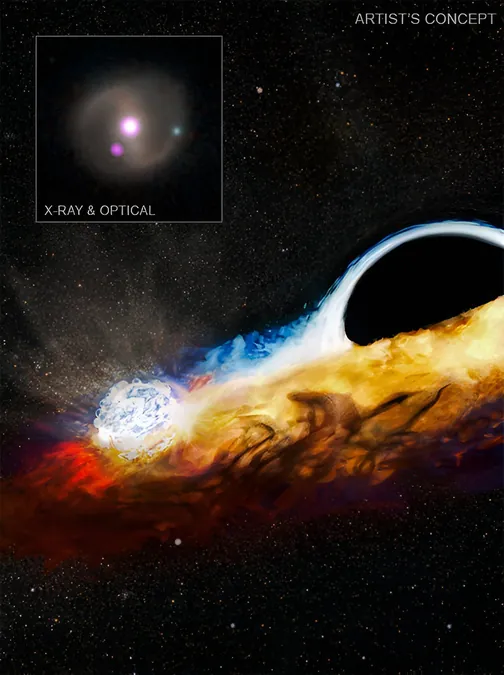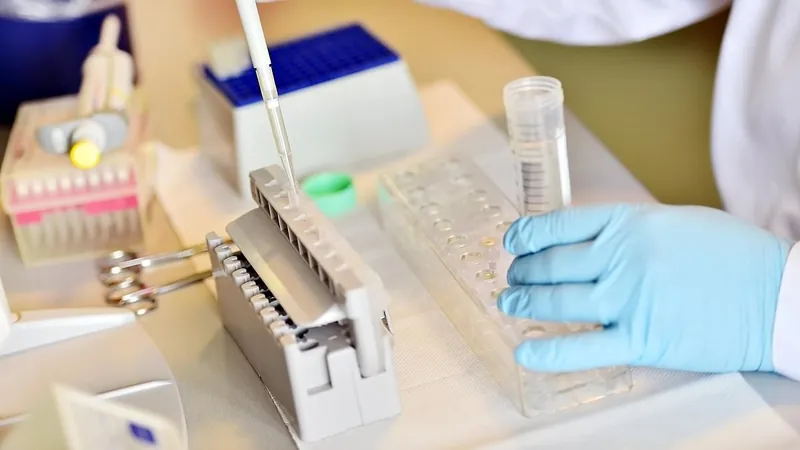
Unbelievable Discovery: Black Hole Wreaks Havoc on Star After Star!
2024-10-09
Author: Jia
In a groundbreaking astronomical revelation, a colossal black hole has not only obliterated one star but is now utilizing the remnants of that stellar wreckage to bombard another unsuspecting star or a smaller black hole that had previously been in a safe orbit. This astonishing discovery was made possible through a collaborative effort involving NASA’s Chandra X-ray Observatory, Hubble Space Telescope, and other advanced telescopes, paving the way for a deeper understanding of the cosmos. The findings were published in the prestigious journal Nature.
The Event Triggering the Discovery
Back in 2019, astronomers first noted an incredible event—a signal indicating that a star had ventured too close to a black hole and was mercilessly torn apart by its powerful gravitational pull. The catastrophe led to the formation of a debris disk orbiting the black hole, much like a cosmic graveyard where the remnants of the star linger.
The Aftermath and New Threats
Fast forward a few years, and this disk has expanded to the point where it now threatens another star or possibly a smaller black hole, orbiting the massive black hole at a seemingly safe distance. The swirling debris is causing a staggering series of collisions, with the orbiting star crashing through the disk approximately once every 48 hours. Each impact generates explosive bursts of X-rays, which have been meticulously captured by the Chandra Observatory.
An Explosive Analogy
“Imagine a diver repeatedly splashing into a pool; each time she enters, she creates a big splash,” noted Matt Nicholl of Queen's University Belfast, the lead author of the study. “In this analogy, the star is the diver, and the debris disk is the pool; with every pass, a huge 'splash' of gas and X-rays is unleashed.”
Understanding Quasi-Periodic Eruptions
Previously, scientists had documented numerous instances of objects getting too close to black holes and being torn apart in spectacular displays of light, known as “tidal disruption events.” However, a new class of repeated bright flashes associated with supermassive black holes, labeled “quasi-periodic eruptions,” has emerged, leaving astronomers scratching their heads about the cause of these mysterious, recurring X-ray bursts.
“We had long speculated about a potential link between these phenomena, and now we finally have concrete proof," exclaimed co-author Dheeraj Pasham from the Massachusetts Institute of Technology. “This is like getting a cosmic two-for-one deal in our quest to solve these mysteries!”
Detection and Confirmation
The tidal disruption event, now referred to as AT2019qiz, was first detected by the Zwicky Transient Facility at the Palomar Observatory. Observations from 2023 using both Chandra and Hubble allowed researchers to examine the remnants after the event, leading to further insights into the size and behavior of the debris disk.
NICER (Neutron Star Interior Composition Explorer) observations confirmed that the event generates X-ray eruptions every 48 hours. Additional data from the Swift Observatory and India’s AstroSat telescope corroborated these findings, tightening the connection between the disk and the observed X-ray flares.
Significance of the Findings
Using ultraviolet data from Hubble, scientists determined the disk has expanded enough to potentially interact with any objects orbiting the black hole with a period shorter than around a week. “This marks a significant breakthrough in our understanding of the origins of these regular eruptions,” stated Andrew Mummery from Oxford University, indicating that researchers must anticipate a delay after a star’s destruction before these eruptions begin.
The implications of this research extend beyond just understanding individual events; it heralds a new era in the search for more quasi-periodic eruptions linked to tidal disruption events. Identifying additional occurrences could facilitate measurements of the prevalence and distances of celestial objects in close orbits around supermassive black holes, potentially revealing excellent targets for future gravitational wave observatories.
Conclusion
The groundbreaking work done by NASA's missions exemplifies the international collaboration and advanced technology at play in unraveling the complex mysteries of our universe. As scientists continue to observe and analyze these astonishing phenomena, the secrets of black holes and their chaotic interactions with stars may change everything we think we know about the cosmos! Prepare yourself for further cosmic revelations!




 Brasil (PT)
Brasil (PT)
 Canada (EN)
Canada (EN)
 Chile (ES)
Chile (ES)
 España (ES)
España (ES)
 France (FR)
France (FR)
 Hong Kong (EN)
Hong Kong (EN)
 Italia (IT)
Italia (IT)
 日本 (JA)
日本 (JA)
 Magyarország (HU)
Magyarország (HU)
 Norge (NO)
Norge (NO)
 Polska (PL)
Polska (PL)
 Schweiz (DE)
Schweiz (DE)
 Singapore (EN)
Singapore (EN)
 Sverige (SV)
Sverige (SV)
 Suomi (FI)
Suomi (FI)
 Türkiye (TR)
Türkiye (TR)